![[ACDP flag]](../images/z/za}acdp.gif) image
by Jarig Bakker, 17 Dec 2001
image
by Jarig Bakker, 17 Dec 2001

Last modified: 2006-01-21 by bruce berry
Keywords: south africa | political parties | amp | anc | acdp | azapo | cdp | konserwatiewe party | democratic alliance | democratic party | economic freedom movement |
herstigte nasionale party | independent democrats | inkatha |
Links: FOTW homepage |
search |
disclaimer and copyright |
write us |
mirrors
![[ACDP flag]](../images/z/za}acdp.gif) image
by Jarig Bakker, 17 Dec 2001
image
by Jarig Bakker, 17 Dec 2001
On the top left hand side of this website
is the flag of the African Christian Democratic Party (South Africa) with the
emblem on a white background and the party's initials on the bottom. When flown
it is of normal flag dimensions. The ACDP was organized prior to the 1994
election, at which it won two seats on a 5 percent vote share; it also secured
representation in three provincial assemblies. In the 1999 elections the ACDP
got 6 seats.
Gary Selikow, 17 Dec 2001
The Logo was designed by a number of ACDP pioneers, and was aimed at
representing what a Party with Biblical Christian principles should entail. The
two arrows from left and right, signify drawing South Africans from the right
and left of race, politics, ideology, Church affiliation, religion, language,
tribe and culture towards the Cross of Jesus Christ in reconciliation, and
unity, in God Almighty, and with one another. The arrows upward and downwards
illustrate die direction up towards God and down towards our fellow South
Africans and our communities. The red border signifies the Blood of Jesus
Christ, surrounding and protecting the ACDP and its members and followers, and
the people of South Africa, as we submit ourselves to the Saviour and Lord of
all creation and of South Africa.
Bruce Berry, 18 Dec 2001
![[ACDP logo]](../images/z/za})acdp.gif) image from this website, reported by
Gary Selikow, 17 Dec 2001
image from this website, reported by
Gary Selikow, 17 Dec 2001
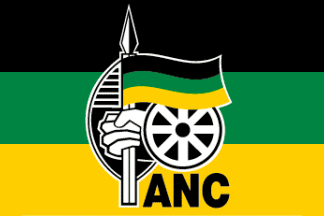 image by Bruce Berry, 23 Apr 2005
image by Bruce Berry, 23 Apr 2005
The ANC has been the ruling party in South Africa since 1994.
The African National Congress (ANC) flag is as indicated above - black, green and gold. The ANC badge (adopted on the 75th anniversary of the organisation in 1987) comprises a fist holding a traditional spear superimposed on a traditional shield adjacent to a cogwheel.The ANC flag was adopted during their party congress in 1925. There
is no record on the ANC official website about why they chose the black,
green and yellow colours. I have, however, heard a tale (the source
no longer remembered) that a delegation from Jamaica
attended this congress as observers that year and that they brought the
colours with them as a gift! If true, this would mean that the ANC
received the colours from the Jamaicans and not the other way around. It
would also mean that Jamaica's colours date back much further than the 1960s. Was there perhaps an earlier political movement in Jamaica (circa
the 1920s) with these colours for a party flag?
It is to be noted that the ANC is one of the oldest black African political
movements, having been established as such in 1912, but built upon an even
earlier movement. It was therefore regarded as the senior liberation
movement in Africa and at least three of the neighbouring countries adapted
the ANC colours for their own use. So we see the flags of Mozambique,
Tanzania and Zimbabwe all containing
the colours black, green and yellow/gold.
Andre Burgerss, 28 Apr 2003
A popular variation of the ANC flag is the plain green, yellow and black
tricolour.
Jorge Candeias, 02 July 1998
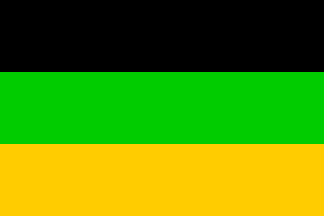 image by Jorge Candeias, 02 July 1998
image by Jorge Candeias, 02 July 1998You are partly correct. The original ANC flag was just the plain green,
yellow, black horizontal tricolour but in 1993 it was announced that the
badge of the organisation would be added to the centre of the flag. The
badge had been adopted on the 75th anniversary of the organisation in January
1987.
Both types of flags are in use - the original version being more popular
with "the masses" for obvious reasons. I noticed at a recent ANC news conference
that a large flag containing the badge was hanging on the wall behind.
The badge is also often displayed on T-shirts, peak caps and the like.
Bruce Berry, 02 July 1998
Only the plain black/green/yellow horizontal tricolour was used until
1987. Although the logo has "officially" been added, the plain version
is still being used by supporters at rallies and such like. The flag with
the logo, and the logo itself, is used by the Party.
Bruce Berry, 10 Nov 1999
I found the website and flag of the African National Congress (South
Africa) which is already in FOTW website but with different dimensions: 3:4 instead of 2:3. Can anyone tell which is the correct
size?
M.V. Blanes, 10 Oct 2000
Flags in South Africa are usually made to the proportion 2:3.
Although not registered with the Bureau of Heraldry (which would lay down
specific proportions), I would guess that the ANC flag would follow the
usual practice of 2:3.
Bruce Berry, 11 Oct 2000
In browsing through your website, I came across a misrepresentation of the Azanian People's Organisation flag and
logo. As outlined in its constitution, the logo and flag are described below. As for
being a small socialist party in South Africa, this can only be assumed to be a perception, rather than a fact, whose basis has not been illustrated.
SECTION 8
LOGO OF THE ORGANISATION
The Logo of the organisation shall be a right hand Black clenched fist facing forward with a Red Star imposed on the Wrist on a Gold
Background.
SECTION 9
FLAG OF THE ORGANISATION
The flag of the organisation shall be a rectangle with the horizontal side being the longest. A diagonal line from the bottom left hand corner
divides the rectangle into two triangles. The upper triangle shall be Gold and the lower triangle shall Black. A Red Star is imposed on the
top left hand corner.
Simphiwe Hashe, 16 Mar 2004
![[AZAPO logo]](../images/z/za}azapl.jpg) image from this website, reported
by Gary Selikow, 06 Oct 2001
image from this website, reported
by Gary Selikow, 06 Oct 2001
![[Flag of Africa Moral Party]](../images/z/za}amp.gif) image from this website, reported
by Franc van Diest, 02 Aug 2001
image from this website, reported
by Franc van Diest, 02 Aug 2001
According to this webpage
the party was founded 11 December 1998 and led by Mr. Salim Ncube. They have
a vision for a Moral South Africa, under which there will be safety and security and peace.
Regarding homosexuality: "we will not allow a handful neo-liberals to destroy
our society." They advocate the return of the death penalty.
Franc van Diest, 02 Aug 2001
 image
by Martin Grieve, 17 Dec 2003
image
by Martin Grieve, 17 Dec 2003
The flag of the Christian Democratic Party of South Africa is shown on their website.
The party emblem is in the centre - the globe and cross- with stripes of equal size
and dimensions as in the Haiti flag. The top stripe is blue and the bottom stripe green.
Gary Selikow, 17 Dec 2003
![[Conservative Party / Konserwatiewe Party flag]](../images/z/za}kp.gif) image
by Mark Sensen, 20 Oct 1997
image
by Mark Sensen, 20 Oct 1997The logo of the Conservative Party or Konserwatiewe Party van
Suid-Afrika is accompanied right and left by the flag of the
ZAR
(Zuid-Afrikaansche Republiek) at this website,
probably connected with the Vryheidsvlag of the Afrikaner Popular Front.
Jarig Bakker, 08 Jan 2002
The flag of the Conservative Party was the
same basic design old
South African flag (O-W-B) with the party logo in the center but with the top
stripe being lemon-yellow.
Jaume Ollé, 20 Jan 2002
The Conservative Party was formed in March 1982 by factions from the
ring-wing of the then ruling National Party (NP). Its emblem consisted of
a blue "KP" (for its Afrikaans initials Konserwatiewe Party)
fimbriated in white on a yellow triangle. Being faithful to its NP
origins, the CP wished to stick to NP colours as far as possible and simply
replaced the orange with yellow. According to Philip Rault's paper on
Afrikaner Political Flags the colours have no particular meaning.
The party's first flag was adopted in 1982, with the whole "KP" emblem being
placed on a tricolour flag divided diagonally per bend sinister yellow, white
and blue. In the late 1980s a second flag was adopted, being divided per
bend sinister yellow over blue with the "KP" logo, fimbriated in yellow in a
white rectangle in the centre. A third flag variant was adopted at a party
rally held at the Voortrekker Monument near Pretoria on 26 May 1990. This
was a horizontal tricolour of yellow, white and blue with the blue "KP" logo,
fimbriated white on a yellow rectangle in the centre of the white stripe.
Bruce Berry, 23 Jan 2002
In November 2003 the Conservative/Konserwatiewe Party disbanded and merged
with the Vryheidsfront to form the Vryheidfront Plus.
Gary Selikow, 02 Feb 2005
The Democratic Party (DP) and the New
National Party (NNP) recently merged to form the Democratic Alliance (DA).
The idea behind this merger is to form a united opposition in South Africa
for the forthcoming municipal elections which are to be held in November.
New symbols have been adopted for the Democratic Alliance but these are
not yet shown on the websites of either the DP or NNP.
Bruce Berry, 04 Aug 2000
![[Democratic Alliance logo]](../images/z/za}dal.gif) image from this website, reported by
Gary Selikow, 14 Oct 2001
image from this website, reported by
Gary Selikow, 14 Oct 2001
![[Flag of Democratic Party]](../images/z/za}dp.gif) image
by Gary Selikow, 02 Aug 2000
image
by Gary Selikow, 02 Aug 2000
The Democratic Party (DP) was formed on 8 April 1989, when the former Progressive
Federal Party, Independent Party and National Democratic Movement merged.
Under the combined leadership of Zach de Beer, Denis Worrall and Wynand
Malan, the DP won 36 seats in Parliament in the general election of September
that year. However, the history of the DP goes back to 1959 when a number
of liberal members of the United Party broke away to form the Progressive
Party. The cause of the split was the UP's inability to find a clear-cut
alternative to the National Party's apartheid policy. The PP took its stand
on constitutional reform, calling for an entrenched Constitution incorporating
a Bill of Rights, for an independent judiciary and for a federal Constitution
in which the powers of the provinces would be constitutionally protected.
It stood for an economy based upon free enterprise. It would be 35
years before the members of the Progressive Party saw their ideals realised
in South Africa's interim Constitution. In the 1961 election only Mrs Helen
Suzman kept her seat in Parliament for the PP. Thus began one of the great
parliamentary performances of all time: Mrs Suzman sat alone for 13 years,
the sole principled opponent of racial discrimination in the whole South
African Parliament. She fought against detention without trial, pass laws,
influx control, job reservation on grounds of colour, racially separate
amenities, Group Areas and forced removals. She demanded trade union rights
for blacks and fought for better wages and working conditions. In 1974
six more PP members won seats in Parliament. Soon after this the PP merged
with a new breakaway group from the United Party, the Reform Party, to
become the Progressive Reform Party in 1975. In 1977 another group of UP
members left the Party to form the Committee for a United Opposition, which
then joined the PRP to form the Progressive Federal Party. During 1987
Denis Worrall resigned as South African ambassador in London to return
to politics. He formed the Independent Movement to fight the 1987 general
election. Only Wynand Malan won his seat and when Mr Malan left the Independent
Movement, Mr Worrall formed the Independent Party. Mr Malan, together with
others, formed the National Democratic Movement. The PFP had lost a number
of Parliamentary seats in the 1987 election and in 1988 Zach de Beer became
the PFP leader. He continued negotiations which culminated in the IP, NDM
and PFP disbanding to form the Democratic Party in April 1989. The National
Party government immediately called a general election for September of
that year, in which the DP improved its position while the NP lost seats
both to the DP and to the right-wing Conservative Party. This was the turning
point for NP leader FW de Klerk, who announced a radical change in government
policy on February 2 1990. With the unbanning of the ANC, PAC and other
liberation organisations, and the release of Nelson Mandela, the process
of negotiating a peaceful solution to South Africa's political impasse
began. DP leader Zach de Beer was chosen as the first Management Committee
Chairman of Codesa. Both in Codesa and the subsequent Multi-Party Negotiating
Process held at the World Trade Centre in Kempton Park, the DP played a
vital role in the negotiation of an interim Constitution which included
most of the principles and ideals around which the PP was formed in 1959.
The April 1994 general election was the liberation election, the first
in which all South Africans voted together. The ANC recorded a significant
victory, with the DP only winning 1,7% of the vote on the national level.
With only 10 Members of Parliament, and under the leadership of Tony Leon,
the DP began a new fight: the fight for the protection of human rights
and the extension of federalism and free enterprise in South Africa. In
the 1999 General election the DP vastly improved its showing becoming the
official opposition with 9.6% of the votes and 44 seats
Gary Selikow, 02 Aug 2000
 image by Martin
Grieve, 17 Dec 2003
image by Martin
Grieve, 17 Dec 2003
The Economic Freedom Movement is a new libertarian political party in South Africa.
Its emblem, in the form of a green, purple and yellow flower can be found
this website.
Gary Selikow, 17 Dec 2003
The flag of the liberal The EZPZ New Generation Political Party is shown on
their website.
Gary Selikow, 16 Dec 2003
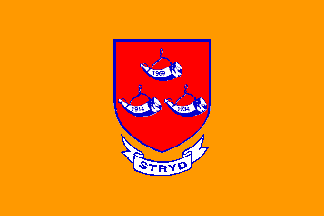 image
by Gary Selikow, 02 Feb 2005
image
by Gary Selikow, 02 Feb 2005
Here is the logo of the of the Herstigte Nasionale Party (HNP)
(Re-constructed National Party of South Africa), an ultra-conservative
Afrikaaner Party in South Africa shown on this website
http://www.hnp.org.za/
hnp.gif) image from this website, reported by
Gary Selikow, 02 Feb 2005
image from this website, reported by
Gary Selikow, 02 Feb 2005
The logo at the top left of the three powder horns on the red shield
is flown on an orange flag.
Gary Selikow, 02 Feb 2005
The correct translation for 'Herstigte' into English would be
'Re-established' - thus the Re-established National Party
Andre Burgers, 02 Feb 2005
The three so-called 'powder horns' were most likely taken from the Arms of the
Orange Free State Republic. They were not powder horns at all but the bugle
horns of the House of Orange after whom the republic was indirectly named. The
name came from the Orange River which was named after the House of Orange and in
1854 the newly established republic approached King Willem III of the
Netherlands for the grant of a arms and a flag. As far as I know still the
only case in history where a republic has asked a monarch for such a grant.
Although not strictly flag related, it might be enlightening to give a potted
history of South African political parties during the last century so that we
will know where the HNP fits into the picture.
When the Union of South Africa was formed in in 1910
from the two British colonies of the Cape and
Natal as well as the two former Boer republics of the
Transvaal and the Orange Free
State, the Afrikaner parties in the former republics and the Cape allied with
moderate English parties in the former colonies, formed the South African Party
(SAP) which in turn formed the first Union government under the premiership of
General Louis Botha (former Boer Commander in Chief). In 1912, Gen JBM Hertzog
broke away from the SAP of Gen. Louis Botha on questions of policy with respect
to relations with Britain and in 1914 formed the National Party
for Afrikaners. The NP won
the 1924 elections allied with the English Labour Party to form the so-called
Pact government. The Pact stayed in power until 1933 when the world wide
economic crises and a severe three year drought in the country forced Hertzog
and Jan Smuts (who had succeeded Botha as leader of the SAP) to form a national
coalition government. The NP and the SAP fused in 1935 to form the United South
African National Party, subsequently known simply as the United Party (UP),
under the leadership of Hertzog with Smuts as his deputy. A part of the NP under
Dr DF Malan refused to join in the fusion and broke away to form the 'Gesuiwerde'
National Party (that is the 'purified' NP). The outbreak of World War II caused
the UP to split on the question of South Africa's participation. Smuts was of
the opinion that SA, as a member of the British Empire, was automatically at war
with Germany. Hertzog was of the opinion that the war was a European
matter and that South Africa should remain neutral. Parliament voted on 6
September 1939 in favour of Smuts by 11 votes and Hertzog had to resign. He
broke away from the UP to form the Afrikaner Party. After his death, in 1941,
his party now
under the leadership of NJ Havenga, joined with the Gesuiwerdes to form the 'Herenigde'
National Party (that is the 'Re-united' National Party or HNP). After defeating
Smuts in the 1948 elections, the HNP resumed the old name of National Party.
This party ruled the country until 1994 when the ANC of
Nelson Mandela took over. In the early 1970s the NP started easing off slightly
on the previously rigorously applied apartheid policies which caused its extreme
right wing under Albert Hertzog (son of the old general) to break away to form
the 'Herstigte' National Party or 'Re-established' NP.
Now they are all history.
Andre Burgers, 04 Feb 2005
According to Philip Rault's paper on Afrikaner Political
Flags presented at the XVII International Congress of Vexillology in Cape
Town (1997) the HNP used a simple tricolour of orange, white and black.
Having its origins as a breakaway group from the National Party in 1969, the HNP
as with the Conservative Party, wished to stay as close to the traditional NP colours of orange, white and blue. Orange white and green were considered
because of the green in the Transvaal flag but the green was rejected in favor
of black because it was closer to the blue than green and with the black/white
contrast it suggested something of the political situation in South Africa.
Rault goes on further to say that sometimes the HNP flag design was adorned with
letters and slogans on stickers, letterheads, shirts etc. but never on actual
flags.
Bruce Berry, 06 Feb 2005
Notice the middle three stripes are the same as the ANC indicating their
earlier alliance!
Bruce Berry, 25 April 1996
![[Inkatha Freedom Party other flag]](../images/z/za}ifp1.gif) image
by Ole Andersen, 08 Jun 1999
image
by Ole Andersen, 08 Jun 1999I read the page on the IFP and saw that Carsten Linke's
image was 1:1, whereas Bruce said it should be 2:3.
I have resized
his image and made a new one for the 'official' version Bruce mentioned.
Ole Andersen, 08 Jun 1999
2:3 is official although there are a number of variations (some home-made)
which are seen which do not conform to this.
Bruce Berry, 08 Jun 1999
![[IFP flag with logo]](../images/z/za}ifp2.gif) image
by Rob Raeside, 5 Oct 2001
image
by Rob Raeside, 5 Oct 2001
Please add the new emblem of the Inkatha Freedom Party in your page
on Political Parties of South Africa which can be seen at the Inkatha
Freedom Party homepage. The emblem is sometimes flown on the IFP flags you have shown on your
website. The emblem is found in the middle of the flag. At party rallies
the plain flag, without the emblem, is often seen.
Gary Selikow, 4 Oct 2001
![[National Party]](../images/z/za-np.gif) image
by Bruce Berry, 25 Apr 1996
image
by Bruce Berry, 25 Apr 1996
The National Party (NP) was the ruling party in South Africa from 1948 until 26 April 1994 when the ANC came to power. The NP was formed in 1912 and was committed to the defence of Afrikaner interests, the abandonment of South Africa's ties with Britain and pursuing a policy of "separate development" between the races - later institutionalized as apartheid. According to Philip Rault's paper on Afrikaner Political Flags presented at the XVII International Congress of Vexillology in Cape Town (1997), the NP initially had no particular emblem or flag. A flag using the then national colours was finally adopted in 1939 comprising a blue gunpowder horn, fimbriated in white, in the centre of an orange field. In 1937 orange was adopted as the official party colour.
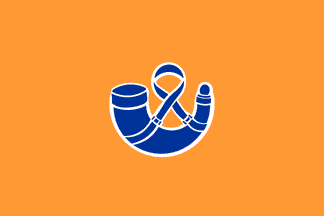 image by
Martin Grieve, 23 Apr 2005
image by
Martin Grieve, 23 Apr 2005
The powder-horn (kruithoring) was symbolic of the Great Trek of 1836 - 1852 when a number of Afrikaners (known as the Voortrekkers) left the Cape Colony to settle in the interior and in the process established a number of Afrikaner republics. Rault comments that the power-horn was borrowed from the arms of the Orange Free State, which were a gift of the Dutch King William III to the Orange Free State government in 1856. Its three horns were taken from the arms of the House of Orange - a hunting horn azure enguichee gules. The House of Orange has used a hunting horn symbol since the middle ages and a horn still features in the arms of the Dutch Royal House as well as in those of the French city of Orange.
The party changed its flag and colours from the former South African national colours of orange, white and blue as well as its kruithoring symbol on 29 April 1993 (see SAVA Newsletter 5/93). The new sun logo symbolizes :
![[Flag of the New National Party]](../images/z/za}nnp.gif) image by Ivan Sarajcic, 23 Mar 1999
image by Ivan Sarajcic, 23 Mar 1999
According to its website (nnp-website), the new NNP logo represents a renewed vigour, and the dynamism and energy
of the New National Party with its new message. It is a modern design which
enhances the strong symbol of the sun and intensifies our colours of gold,
blue and green. Its design reflects and indigenous quality and the broad
based membership of our party. It takes the main elements of our old logo
and moulds them into a single and powerful emblem, which together with
our new slogan, strengthens our image and drives home our message in the
lead up to the 1999 elections and beyond...
Dov Gutterman, 22 Mar 1999
![[Flag of Pan Africanist Congress of Azania]](../images/z/za}pac.gif) image
by Jarig Bakker, 07 Oct 2001
image
by Jarig Bakker, 07 Oct 2001
The flag of the Pan Africanist Congress (PAC) is a green (the same green as on the ANC and IFP flags) with the PAC logo featuring a map of Africa with the star in the place where Ghana is located (to represent Ghana as being the first sub-Saharan African state to achieve independence in the 20th century) in the centre. There are a number of golden rays coming from the "star" radiating across the continent. The PAC flag contains no white and is exclusively, black, gold and green.
The PAC is a small radical left wing black nationalist party that broke
away from the ANC in 1959 in protest at the ANC's domination by the
South
African Communist Party.
Gary Selikow, 06 Oct 2001
![[Logo of Pan Africanist Congress of Azania]](../images/z/za}pacl.gif) image from this website, reported
by Gary Selikow, 06 Oct 2001
image from this website, reported
by Gary Selikow, 06 Oct 2001
![[South african communist party flag]](../images/z/za}sacp.gif) image
by Franc Van Diest, 26 Jan 2002
image
by Franc Van Diest, 26 Jan 2002
The German weekly "Der Spiegel" (12/1999, p.162) has an article "Das Jahrhundert
der Befreiung: Gewaltfeier Widerstand" showing a photo of demonstrators
subtitled "Aufmarsch des ANC in King Williams Town, 1992". One protestor
holds a red flag with five-pointed black star fimbriated yellow, with a yellow
sickle & hammer on it. About a year ago, I saw website of the South African
Communist Party showing the same emblem. Is this a flag of this party?
Ivan Sarajcic, 06 May 2000
About 2-3 years ago I saw a photo of African demonstrators
from the PAC (Pan-Africanist Congress). One man had a drawing on his football
shirt of two crossed flags - that of the ANC (horizontal black-green-yellow), and red flag
with black star with yellow sickle and hammer in the centre.
Victor Lomantsov, 07 May 2000
Yes, this is the flag of the South African Communist Party (SACP). The
SACP is in a tripartite alliance with the ruling ANC and the Confederation
of South African Trade Unions (COSATU). Although numerically very small
in terms of seats in parliament etc., the SACP still exerts quite a strong
influence through the Tripartite alliance.
Bruce Berry, 08 May 2000
The website of the SACP. shows the logo of the South African Communist
Party as being a sickle & hammer in yellow on a black star fimbriated in
yellow on a red field in the canton.
Francisco Manuel Garcia, 21 Sep 2001
The communist Pary of South Africa state on their
website that :
2. SYMBOL AND FLAG
The symbol of the SACP shall be a black star containing a gold hammer
and sickle. The flag of the Party shall be red with the symbol placed in
the top left hand corner.
Although it only mentions a black star (not with a gold border), the symbol (Logo)
shown on their site shows a gold border. Is this is only to give an idea of
how it will look on a red flag?
Franc Van Diest, 26 Jan 2002
![[South african communist party logo]](../images/z/za}sacpl.gif) image from this site, reported by
Francisco
Manuel Garcia, 21 Sep 2001
image from this site, reported by
Francisco
Manuel Garcia, 21 Sep 2001
The United Christian Democratic Party is a moderate Christian Democratic Party in South Africa.
The emblem in the center of the the flag can be found at www.ucdp.org.za on the top left hand of the website.
The flag has the same dimensions of the Indonesian flag , with 2 bands, orange at the top (where their would be red on the Indonesian flag) and white at the bottom, with the UCDP emblem in the center of the flag. The emblem in the center is prominent and
the same size as the emblem on the Cypriot flag.
Gary Selikow, 16 Dec 2003
![[Flag of United Democratic Movement]](../images/z/za}udm.gif) image by Jarig Bakker,
05 Oct 2001
image by Jarig Bakker,
05 Oct 2001
The United Democratic Movement (UDM) is a Social Democratic political party led
by General Bantu Holomisa and has 14 seats in the National Assembly (Parliament). The logo below is often used in the middle of a yellow flag.
Gary Selikow, 04 Oct 2001
United Democratic Movement registered a flag with the South African Bureau of
Heraldry on 07 April 1998 which is described as being:
"A rectangular gold field, proportion 2:3; in the centre thereof, on
a red delve set lozengewise, a green chevron embowed and barbed throughout,
fimbriated gold."
Source: Data
of the Bureau of Heraldry on registered heraldic representations.
Mark Sensen, 19 May 2002
![[UDM logo]](../images/z/za}udml.gif) image from this website, reported by Gary
Selikow, 04 Oct 2001
image from this website, reported by Gary
Selikow, 04 Oct 2001
![[Flag of Vryheidsfront - Freedom Front]](../images/z/za}vf.gif) image from this website,
reported by Franc van Diest, 01 Aug 2001
image from this website,
reported by Franc van Diest, 01 Aug 2001
The Vryheidsfront - Freedom Front - is a rightist Afrikaner party, founded
1994 by Gen. (Ret.) Constand Viljoen. It advocates a "White homeland"
and won 3 seats in the South African Parliament in the 1999 elections.
Franc van Diest, 01 Aug 2001
The Freedom Front is not a "rightist" political party and it is not
in favour of a "WHITE" Homeland.
The Freedom Front is a party that enhances the rights of a specific
community, namely the Afrikaner people. It is not based on race. We are in favour of self-determination for the AFRIKANER People
that includes cultural as well as territorial self-determination.
Dr. Corne Mulder (MP - Freedom Front), 17 Apr 2002
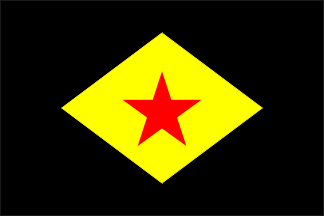 image
by Martin Grieve, 17 Dec 2003
image
by Martin Grieve, 17 Dec 2003
The flag of the Workers Party in South Africa can be found in the middle of their
website.
When the emblem is used as a flag. It is flown in the usual flag dimensions with the emblem in the middle, being the red star on the
yellow diamond on a black background.
Gary Selikow, 16 Dec 2003